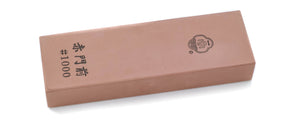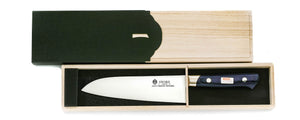While many of us have used kitchen knives before, just how sharp do you think the ones you have used were? Have you tried using a single-edge, Japanese kitchen knife that is focused purely on sharpness?
Introducing our Knife Cutting and Sharpness Workshop, which lets you try cutting with Japanese kitchen knives that have various levels of sharpness (or lack thereof). We offer it at ICHITOI, the second floor of Sakai Ichimonji Mitsuhide's main office.
Visit us and experience true kireaji; the flavor of cutting!
Table of Contents
Workshop Contents
This workshop takes approximately ten to fifteen minutes and involves four key steps.
Cutting Technique Explanation
Firstly, you will learn about pull cutting, a technique used in Japanese cuisine. This style of cutting will be used to measure cutting performance.
Household Knife Cutting
You will try pull cutting with an inexpensive, household santoku knife that has had some use.
Sharpened Knife Cutting
You will try cutting with a couple of different professional-grade double-edged knives, which have been used then sharpened to various degrees to bring back some of their performance. Examples of knives used are santoku, gyuto, and petty knives.
Single-Edged Knife Cutting
You will try cutting with a couple of different traditional, high-end, single-edged knives made from high-carbon steel, which have been well maintained and are focused on cutting performance. Examples of knives used are deba, usuba, and yanagiba knives.
While we normally do this demonstraition using cushion foam (for sustainability purposes as it is converted into cushion material afterwards), sometimes we also have bread and vegetables like daikon, lettuce, and tomato onsite.
This activity is suitable to do for one to two active participants at a time. It is very easy for many people to take turns however, so we commonly see groups of four or five do this experience. With adult supervision, this activity is suitable for those aged twelve and up.
Why We're Doing It
The reason we host this workshop is to educate about sharpness and how important it is, as well as how a knife is safer when it is sharp.
You would be surprised at how common it is that people let their knives get blunt and stay that way, either never replacing them and using a knife that cuts poorly, or replacing the knife with something else inexpensive.
The idea of this demonstration is to showcase that sharpening a knife can lead to amazing results, and a much better time cooking in your own kitchens.
Knives that are sharp cut better, which leads to better tasting food from less cellular degradation from the cutting process.
Of course, part of this experience will just be that cutting with sharp kitchen knives is fun, but we hope to also convey the importance of maintaining your knives, and investing in good ones that perform like this for a long time, while staying easy to maintain.
Dates and Prices
This workshop is held any day there is not another event going on at ICHITOI. You can see ICHITOI's event calendar on its Japanese webpage.
This experience is completely free of charge, so come up to our second floor and say hello anytime! You do not need to purchase anything from us to participate.
If you contact us ahead of time, we can make sure someone is available to guide you through step-by-step, and confirm that this work is running on that day.
We also offer a premium version of this experience as part of our paid VIP Experience, if you want to try cutting and eating some higher end product like seafood or meats
How to Book
Walk-in appointments are accepted and encouraged. You do not need to make a reservation with us to do this sharpening workshop, but you are always welcome to contact us if you want to have a precise time and make sure someone is available.
You can book a session by messaging us through our contact page.































